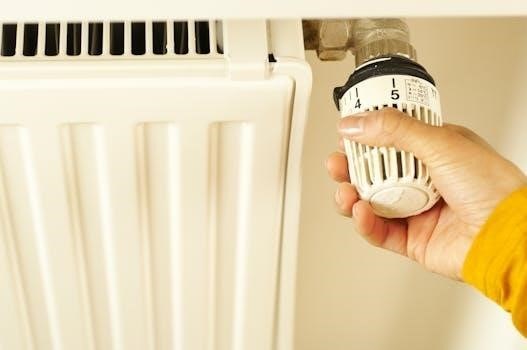PRO T705 Thermostat Manual Article Plan
This comprehensive guide will walk you through the PRO T705 thermostat manual, covering everything from understanding its components and settings to battery replacement and installation. We’ll explore programmable time periods and essential operating instructions for optimal use.
Congratulations on choosing the PRO T705 thermostat! This user-friendly device is designed to provide reliable and efficient climate control for your home or office. The T705 offers a blend of simplicity and functionality, making it easy to manage your heating and cooling needs. This manual will guide you through the features and operation of your new thermostat, ensuring you get the most out of its capabilities.
The PRO T705 is known for its intuitive design and ease of use. Its clear display and simple controls make it accessible for users of all technical abilities. The thermostat is designed to maintain consistent temperatures, creating a comfortable environment while potentially saving energy. By understanding the various settings and functions, you can customize the thermostat to perfectly suit your lifestyle and preferences.
Whether you’re looking to program specific temperature schedules or simply adjust the temperature as needed, the T705 offers the flexibility to meet your needs. This manual will provide step-by-step instructions on how to navigate the thermostat’s features and optimize its performance for your specific heating and cooling system. Get ready to experience the convenience and comfort that the PRO T705 thermostat brings to your home.
Models Covered by the T705 Manual
This manual provides operating instructions for the PRO T705 thermostat, along with other closely related models within the PRO series. While the primary focus is on the T705, many of the features and functions described herein are also applicable to similar models. Please note that specific variations may exist between models, so always refer to the diagrams and instructions that most closely match your particular thermostat.
The information contained in this manual may also be relevant to models such as the T705 and potentially some variations of the T705. While this manual serves as a comprehensive guide, users with different models should pay close attention to any model-specific instructions or notes that may be included. Always verify compatibility and consult supplementary documentation if available, to ensure proper operation and avoid potential issues.
This manual aims to be a versatile resource for users of several PRO series thermostats. By understanding the core functions and principles outlined in this guide, you’ll be well-equipped to operate your thermostat effectively and efficiently. Remember to always prioritize safety and consult a qualified technician if you encounter any difficulties or uncertainties during setup or operation. The ultimate goal is to help you get the most out of your PRO series thermostat, regardless of the specific model you own.
Operating Instructions Overview
This section provides a general overview of the operating instructions for your PRO T705 thermostat. Before diving into specific features, it’s crucial to understand the basic functionalities. The thermostat allows you to control your home’s heating and cooling systems, maintaining a comfortable environment. Key operations include setting the desired temperature, selecting the appropriate system mode (Heat, Off, Cool), and adjusting the fan settings (On, Auto).
To begin, familiarize yourself with the thermostat’s display and buttons. The display shows the current room temperature and the setpoint temperature. The buttons are used to raise or lower the setpoint temperature, change the system mode, and adjust the fan settings. Simple operating instructions are often found on the back of the battery door for quick reference. For more detailed information, refer to the subsequent sections of this manual.
Remember, selecting “Heat” activates the heating system, “Cool” activates the cooling system, and “Off” disables both. The “Fan On” setting runs the fan continuously, while “Fan Auto” cycles the fan only when the heating or cooling system is active. Proper understanding and use of these settings are vital for efficient and comfortable climate control within your home. Always ensure the system is set to “Off” when performing maintenance or replacing batteries for safety.
Getting to Know Your Thermostat Components
Understanding the different components of your PRO T705 thermostat is essential for efficient operation and troubleshooting. The thermostat comprises several key parts, each with a specific function. Firstly, the display screen shows the current room temperature, the setpoint temperature, and various operating modes. Below the display, you’ll find the primary control buttons, typically including up and down arrows for adjusting the temperature.
The thermostat also features a system switch, usually labeled “Heat,” “Off,” and “Cool,” allowing you to select the desired operating mode. A separate fan switch, with options for “On” and “Auto,” controls the fan’s behavior. Additionally, many models include a “Glow-in-the-Dark Light Button” for illuminating the display in low-light conditions. The battery compartment, typically located on the back or side of the unit, houses the batteries that power the thermostat.
Familiarizing yourself with these components will enable you to easily navigate the thermostat’s settings and optimize its performance. Knowing the location and function of each part will also simplify troubleshooting any issues that may arise. For example, understanding the purpose of the fan switch can help you improve air circulation and energy efficiency. Similarly, knowing where the battery compartment is located makes battery replacement quick and straightforward.
Location and Function of the Glow-in-the-Dark Light Button
The PRO T705 thermostat often includes a convenient glow-in-the-dark light button, designed to enhance visibility in dimly lit environments. This button is typically located on the front of the thermostat, often near the display screen or along the edge of the unit. Its purpose is to illuminate the display, making it easier to read the temperature and settings without needing to turn on a separate light source.
The primary function of the glow-in-the-dark light button is to provide temporary backlighting for the thermostat’s display. When pressed, the button activates a small light that illuminates the screen for a short period, usually a few seconds. This feature is particularly useful at night or in rooms with poor lighting, allowing you to quickly check or adjust the thermostat settings without straining your eyes.
To use the glow-in-the-dark light button, simply press it firmly. The display should light up immediately, providing clear visibility of the temperature and settings. Once the button is released, the light will automatically turn off after a brief interval to conserve battery power. This simple yet effective feature adds to the overall user-friendliness of the PRO T705 thermostat, making it a practical choice for any home.
Understanding the Fan Switch Settings (On/Auto)
The PRO T705 thermostat features a fan switch with two primary settings⁚ “On” and “Auto.” Understanding these settings is crucial for optimizing your home’s comfort and energy efficiency. The “On” setting forces the fan to run continuously, regardless of whether the heating or cooling system is actively operating. This setting is useful for maintaining consistent air circulation throughout your home and can help to eliminate stagnant air pockets.
In contrast, the “Auto” setting allows the fan to operate only when the heating or cooling system is running. When the thermostat calls for heat or cool, the fan will automatically turn on to distribute the conditioned air. Once the desired temperature is reached, the fan will turn off along with the heating or cooling system. This setting is generally more energy-efficient, as the fan only runs when necessary.
Choosing between “On” and “Auto” depends on your specific needs and preferences. If you prioritize consistent air circulation and are willing to accept slightly higher energy consumption, the “On” setting may be preferable. However, if you are primarily concerned with energy efficiency and only need the fan to run when the heating or cooling system is active, the “Auto” setting is the more sensible choice. Experiment with both settings to determine which best suits your comfort needs and energy goals.
System Switch Settings (Heat/Off/Cool)
The system switch on your PRO T705 thermostat controls the operational mode of your HVAC system, offering three distinct settings⁚ “Heat,” “Off,” and “Cool.” Selecting the appropriate setting is paramount for maintaining a comfortable indoor environment while optimizing energy consumption. The “Heat” setting activates your heating system, instructing it to warm your home when the ambient temperature falls below the setpoint on the thermostat.
Conversely, the “Cool” setting engages your air conditioning system, prompting it to cool your home when the ambient temperature rises above the setpoint. This setting is essential during warmer months to ensure a comfortable and refreshing indoor atmosphere. The “Off” setting completely deactivates both the heating and cooling systems, preventing them from operating regardless of the ambient temperature or thermostat settings.

This setting is particularly useful during periods of mild weather when neither heating nor cooling is required, or when you wish to temporarily disable your HVAC system for maintenance or other reasons. Selecting the correct system switch setting is crucial for aligning your HVAC system’s operation with your desired indoor temperature and seasonal needs. Regularly adjusting the system switch ensures efficient energy usage and a consistently comfortable living space.
Battery Replacement Procedures
Maintaining the PRO T705 thermostat’s functionality relies on ensuring fresh batteries are installed when needed. A low battery indicator will appear on the display, signaling the necessity for replacement. To begin, gently remove the thermostat from its subbase by pulling it straight out. Locate the battery compartment, typically on the back of the thermostat unit, and open it.
Remove the old batteries, noting the correct polarity (+ and -) as indicated inside the compartment. Insert two new AA alkaline batteries, ensuring they are aligned with the proper polarity markings; Incorrect battery placement can prevent the thermostat from functioning correctly. Once the new batteries are securely installed, close the battery compartment.
Reattach the thermostat to the subbase by aligning the tabs on the subbase with the corresponding slots on the back of the thermostat. Gently push until the thermostat snaps securely into place. After replacing the batteries, the thermostat may undergo a brief reset period. Verify that the display is functioning correctly and that the low battery indicator is no longer visible. Proper battery replacement ensures uninterrupted thermostat operation and accurate temperature control within your home.
Low Battery Indicator

The PRO T705 thermostat is equipped with a low battery indicator to alert users when the batteries are running low and require replacement. This feature is crucial for maintaining continuous and reliable operation of the thermostat, ensuring accurate temperature control and preventing unexpected shutdowns. When the battery power decreases to a certain level, a specific symbol or message will appear on the thermostat’s display screen. This indicator serves as a clear signal that it’s time to replace the batteries.
The visual representation of the low battery indicator may vary slightly depending on the specific model of the T705 thermostat, but it is generally a universally recognizable icon, such as a battery symbol with a low charge level or a text message like “LOW BATTERY.” Promptly addressing the low battery warning is essential to avoid any disruption in heating or cooling performance. Ignoring the low battery indicator can lead to the thermostat ceasing to function, resulting in discomfort and potential temperature fluctuations within the home.
Refer to the battery replacement procedures outlined in this manual for detailed instructions on how to safely and effectively replace the batteries in your PRO T705 thermostat. Replacing the batteries as soon as the low battery indicator appears will ensure that your thermostat continues to operate efficiently and reliably.

Programmable Time Periods
The PRO T705 thermostat offers the convenience of programmable time periods, allowing users to customize their heating and cooling schedules to match their daily routines and preferences. This feature enables energy savings by automatically adjusting the temperature settings during periods when the home is unoccupied or when different comfort levels are desired.
The thermostat typically provides four programmable time periods per day⁚ Wake, Leave, Return, and Sleep. Each time period can be independently set with a specific start time and desired temperature. For example, during the “Leave” period when the occupants are away at work or school, the thermostat can be programmed to maintain a lower temperature in winter or a higher temperature in summer, reducing energy consumption. Similarly, the “Return” period can be set to restore the temperature to a comfortable level just before the occupants arrive home.
Programming the time periods is usually accomplished through a user-friendly interface on the thermostat’s display. The manual provides detailed instructions on how to navigate the menu, set the start times, and adjust the temperature settings for each time period. By effectively utilizing the programmable time periods, users can optimize their energy usage while maintaining a comfortable indoor environment, leading to significant cost savings on their utility bills.
Installation Guidelines (Height and Location)
Proper installation of the PRO T705 thermostat is crucial for accurate temperature sensing and optimal performance. The thermostat should be installed approximately 4 to 5 feet (1.2 to 1.5 meters) above the floor. This height ensures that the thermostat measures the average temperature of the living space, avoiding temperature readings that are too close to the floor or ceiling, which may not accurately reflect the overall room temperature.
Selecting the right location is equally important. The thermostat should be installed on an interior wall, away from direct sunlight, drafts, and heat sources. Avoid installing the thermostat near windows, doors, exterior walls, or appliances that generate heat, such as lamps or televisions. These factors can affect the thermostat’s ability to accurately measure the room temperature and may cause it to turn on or off prematurely.
Choose a location with good air circulation. This allows the thermostat to sense temperature changes more quickly and efficiently. Avoid placing the thermostat behind furniture or curtains, as this can restrict airflow and lead to inaccurate temperature readings. By following these installation guidelines, you can ensure that your PRO T705 thermostat operates effectively and provides consistent, reliable temperature control.
Subbase Installation and Thermostat Attachment
The subbase installation is the first step in physically mounting the PRO T705 thermostat. Begin by carefully separating the thermostat from its subbase. Typically, this involves gently pulling the thermostat away from the subbase, as it’s usually held in place by pressure clips or tabs. Ensure the power to the heating/cooling system is turned off at the breaker before proceeding with any wiring or installation steps.

Position the subbase on the wall at the desired location, following the height and location guidelines mentioned previously. Use a level to ensure the subbase is perfectly horizontal for a professional appearance and accurate operation. Mark the mounting holes on the wall through the subbase. Drill pilot holes at the marked locations, and if necessary, use wall anchors for secure attachment, especially on drywall or plaster.
Connect the appropriate wires from your heating/cooling system to the corresponding terminals on the subbase, according to the wiring diagram provided in the manual. Ensure all connections are secure and properly insulated. Once the wiring is complete, align the four tabs on the subbase with the corresponding slots on the back of the thermostat. Gently push the thermostat onto the subbase until it snaps securely into place. This ensures a reliable electrical connection and proper functioning of the thermostat.
